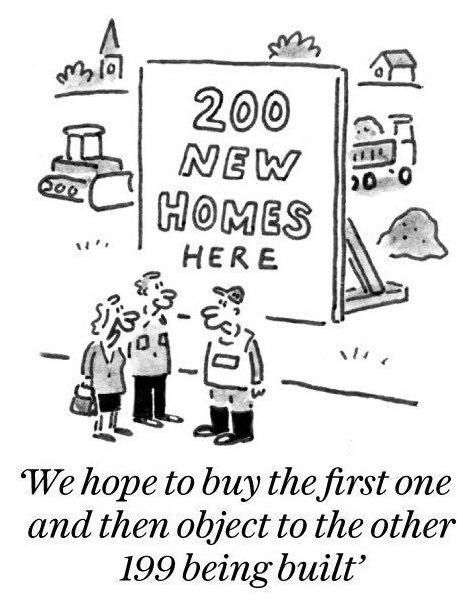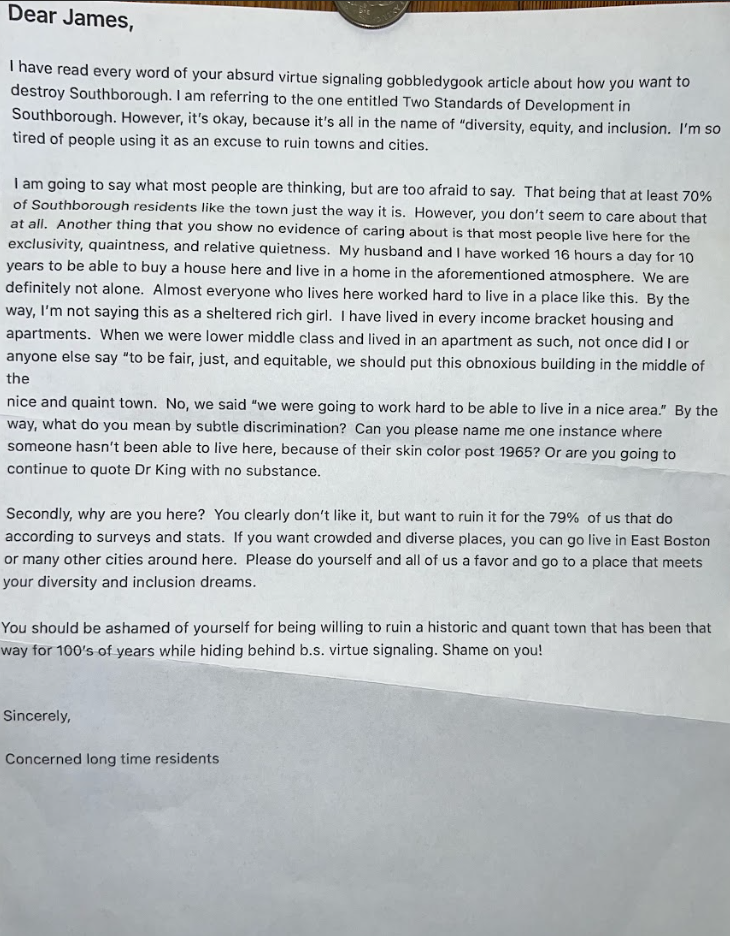Back in August, I wrote a Letter to MySouthborough.com to argue in favor of multi-unit developments in town. I argued that we need to consider their positives in addition to the drawbacks such as traffic and height. Last week, I received an anonymous letter demanding I leave and accusing me of wanting to destroy Southborough. (The letter in full can be read above). This is disheartening, because I love Southborough. I think more people should be able to live here. What makes Southborough great won’t disappear with more people, and I think to argue such casts a negative light on our otherwise welcoming town.
The anonymous letter-sender conflates “exclusivity, quaintness, and relative quietness.” The last two are admirable goals that we should try to achieve. Exclusivity, however, has no material benefit. Exclusivity does not benefit our children’s education; exclusivity does not make our beautiful forests and open space more enjoyable; exclusivity does not make us closer as neighbors; exclusivity does not enrich us in any way. Exclusivity is a one-way ticket to poverty: accelerating our declining school-age population and closing our schools; ensuring our teachers and essential workers cannot afford to live in the town they serve; and can only give Southborough a negative reputation. We do not live in a zero-sum world. By including others, by opening up Southborough to new neighbors, we will benefit ourselves tenfold than if we entombed ourselves.
Finally, as I have argued repeatedly, building more housing will not “ruin a historic and quant town that has been that way for 100’s of years.” Most houses in town were not built in 1727. Nobody objected to their own home being built, only to ones coming after. We do not need to Boston-ify Southborough. We don’t need very large buildings and we definitely don’t need skyscrapers. But I have not yet heard a convincing argument why we should stop our growth now, why 10,409 residents is the perfect number for Southborough. As I argued back in August, people have been demanding we stop Southborough’s growth since at least 1985, but are we really worse off than 40 years ago?

I would like to address one more claim of the anonymous-letter sender.
“Can you please name me one instance where someone hasn’t been able to live here, because of their skin color post 1965? Or are you going to continue to quote Dr King with no substance.”
I think this question is purposefully misleading because Dr. King’s message is quite clear. I quoted him partially in his 1965 address to the Massachusetts Legislature, but I will let him speak for himself at length:
We realize that the forces of evil are still alive. We see lawlessness in the form of the Ku Klux Klan. We see forces still resisting through various evasive schemes, and through various systems of intraposition and nullification.
Beyond that we see subtle forms of discrimination in all of our communities, expressed in housing discrimination, de facto segregation in the public schools, and expressed in job discrimination and unemployment. But I am convinced, as I stand before you this evening, that if America and democracy are to live, segregation must die! In real sense segregation is cancer in the body politic which must be removed before our moral health can be realized.
In a real sense segregation, whether it is de jure segregation of certain sections of the South or de facto segregation of the North, is a new form of slavery covered up with certain niceties of complexities. And all men of goodwill all over this nation must work together passionately and unrelentingly to solve this problem!
…
Now is the time for strong legislation to end discrimination in housing. There also must be vigorous enforcement of such legislation! Now is the time for men of goodwill to get together to make it possible for better housing conditions to be brought into being for low-income and middle-income families.1
Dr. King called the “de facto segregation” of Boston’s suburbs “a new form of slavery covered up with certain niceties and complexities.” Feel free to disagree with MLK, but you can’t accuse me of misquoting him.
This year, in the report Exclusionary by Design, the researcher Amy Dain came to a similar conclusion:
Throughout the late 1960s and early 1970s, journalists and columnists, state and federal officials, municipal planners, academics, housing advocates, and civil rights leaders and activists were calling out the racist, exclusionary motives behind zoning and calling for reform, to allow apartment construction, to enable desegregation. There had never been more awareness and public acknowledgement of zoning’s unseemly role keeping lower income people and minorities from the opportunities of affluent suburbs. Civil rights activists had formed committees in many suburbs to address fair employment and fair housing, including zoning reform. As suburb after suburb voted to cancel zoning for multifamily housing, voters could not have been ignorant about the implications of their votes—for segregation.2
To be clear, however, today’s housing crisis is not limited to racial segregation. The academic Richard Kahlenberg, who I had the chance to meet last month, persuasively argues that class discrimination is as, if not more, pervasive than racial discrimination today in places like Massachusetts. Kahlenberg argues that:
Across the country, a lot of good white liberals, people who purchase copies of White Fragility and decry the U.S. Supreme Court for ending affirmative action, sleep every night in exclusive suburbs that socially engineer economic … segregation by government edict. The huge inequalities between upscale municipalities and their poorer neighbors didn’t just happen; they are in large measure the product of [zoning] laws that are hard to square with the inclusive In This House, We Believe signs on lawns in many highly educated, deep-blue suburbs…
Many people seeking a better life for their children would, in fact, relish an opportunity to move to [these suburbs].3
1. “Address Of Reverend Doctor Martin Luther King, Jr. Delivered To A Joint Convention Of The Two Houses Of The General Court Of Massachusetts.” April 22, 1965, pages 8-9. https://archives.lib.state.ma.us/bitstream/handle/2452/70100/ocn701908905.pdf.
2. Dain, Amy. “Exclusionary by Design: An Investigation of Zoning’s Use as a Tool of Race, Class, and Family Exclusion in Boston’s Suburbs, 1920 to Today.” October, 2023, page 23. https://www.bostonindicators.org/reports/report-detail-pages/exclusionary-by-design.
3. Kahlenberg, Richard. “Liberal Suburbs Have Their Own Border Wall.” The Atlantic, July 23, 2023. https://www.theatlantic.com/ideas/archive/2023/07/wealthy-liberal-suburbs-economic-segregation-scarsdale/674792/.
